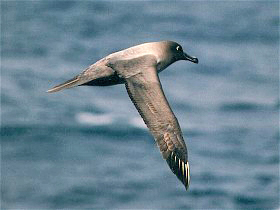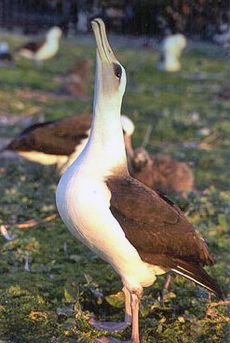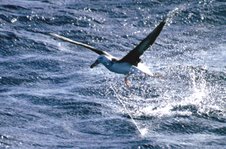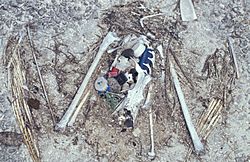Albatross facts for kids
Quick facts for kids Albatross |
|
|---|---|
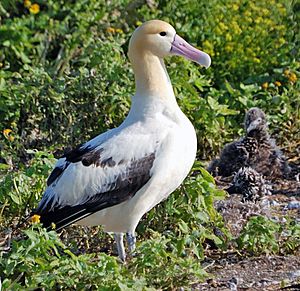 |
|
| Short-tailed Albatross (Phoebastria albatrus) | |
| Scientific classification | |
| Kingdom: | |
| Phylum: | |
| Class: | |
| Subclass: | |
| Infraclass: |
Neoaves
|
| Order: | |
| Family: |
Diomedeidae
George Robert Gray 1840
|
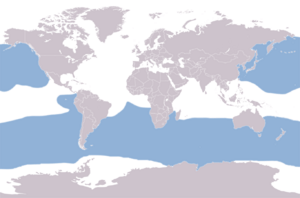 |
|
| Global range (In blue) | |
Albatrosses are large seabirds which belong to the biological family Diomedeidae. They live in the region of the Southern Ocean and the North Pacific Ocean. They are not found in the North Atlantic region, but their fossils have been found there, which shows that they used to live there. There are four main species of albatross: Great Albatrosses, North Pacific Albatrosses, Mollymawks and Sooty Albatrosses. These are divided into twenty-one species identified by the World Conservation Union (ICUN).
Great Albatrosses are among the largest of flying birds. They are very big. All albatrosses are very good at flying, spending much of their life in the air. They eat squid, fish and krill. Albatrosses come ashore to make their nests, mostly on islands, and usually near the nests of other birds.
Nineteen of the twenty-one species of albatross are endangered. This is partly because animals such as rats and cats attack their eggs, chicks, and sometimes adult birds as well. Pollution of the oceans, such as plastic waste and oils spills, also kills albatrosses. Sometimes there may be not enough fish to eat because of over-fishing. The main reason why albatross are endangered is longline fishing which causes many albatross to get caught on hooks that have been baited to catch fish. This causes the birds to drown.
Contents
Biology
Flight
Albatrosses are very large. The bill is large, strong and sharp. This bill is made of horny plates. Along the sides are the two "tubes". They are actually long nostrils. The tubes of all albatrosses are on the sides of the bill. They help the albatrosses develop their sense of smell a lot. The feet have no last toe and the three other toes are all webbed. Their legs are quite strong, and they can walk well on land, unlike other sea birds.
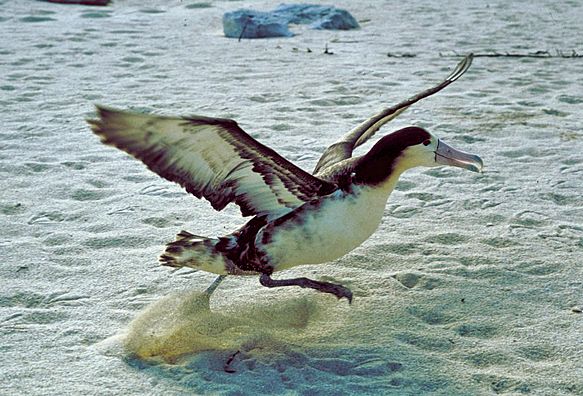
Albatrosses need to take salt out of their body because they drink ocean water. All birds have a large gland at the top part of their bill, above their eyes. This gland is sometimes useless to birds that do not need it. However, albatrosses use them to help take out saltwater. Scientists are not sure how it works exactly. However, they know that it helps take out the salt. It makes a liquid that makes the saltwater drip out of their nose.
The adult albatrosses usually have a dark upper-wing and back, and white undersides when they are getting ready to take flight. Albatrosses take several years to get their full adult feathers.
The wings of the largest albatrosses (genus Diomedea) can be up to 340 cm (11.2 ft).
Albatrosses flying north from their family sometimes fly in a clockwise direction, and those flying south will fly the opposite. The most energy used up in their journey is not when they travel a long way, but when they land, take-off, and hunt. This helps the albatross fly more longer distances and find good food. They can fly easily over wind and waves. However, because their long wings do not have strong muscles or energy, they cannot flap while they fly. Because of this, albatrosses in calm seas must stop and rest on the surface of the ocean until the wind begins to blow harder. When taking-off, albatrosses need to run first to help the wing make lift. Albatrosses are known for their clumsiness when landing.
Locations
Most albatrosses are found in the southern hemisphere from Antarctica to Australia, South Africa and South America. However, the four North Pacific albatrosses live elsewhere. Three of them are in the North Pacific, from Hawaii to Japan, California and Alaska. The last one, the Waved Albatross, is in the Galapagos Islands and finds food in the coast of South America.
It is not known clearly why the albatrosses became extinct in the North Atlantic. Some think that it was because the sea level rose at that time. Some kind of albatrosses that live in the south have usually been trapped in the North Atlantic, and are forced to stay there for a long time.
Sometimes scientists may use the satellite when trying to learn about albatrosses. They try to find out about the way albatrosses go across the ocean to find food with the satellites. There is proof that the sea separates different kinds of species of the Albatross. There is also proof of different pathways for the two sexes of the same kind of species. A study of Tristan Albatrosses living on the Gough Island showed that males look for food on the west and the females go around the east.
Diet
The albatross eats cephalopods, fish, crustaceans and offal. Sometimes, they may also eat carrion and or other kinds of zooplankton. However, the importance of each food is different according to each species. Some may like to eat only squids, or others might eat more krill or fish. From the two albatross species that live in Hawaii, one of them, the Black-footed Albatross, eats mostly fish. The other one, the Laysan Albatross, eats more squids instead.
Sometimes albatrosses may use the help of other animals to eat. For example, some squids are too big to be caught alive by the albatross. Instead, albatrosses eat squids that die after mating, or after they have been vomited by squid-eating whales (such as sperm whales and pilot whales). Other species, like the Black-browed Albatross or the Grey-headed Albatross, eat smaller species of squid that sink after they die, and they do not scavenge a lot. Also, sometimes the Waved Albatross has been seen stealing food from other birds.
Until now, it was thought that the albatrosses ate and found their food at the surface of the sea, this included dead squid and fish pushed to the surface by the waves, other animals that had eaten them, or death. This was thought because some species do not dive deeper than a metre. However, this theory was not true because some species have a mean (average) diving depth of almost 5 metres and can dive as deep as 12.5 metres. They have now been seen to eat from the surface, diving to catch prey and sometimes also plunging from the air to snatch their prey.
Breeding and dancing
Albatrosses live together, and they usually nest on islands where no people live. Many Buller's Albatrosses and Black-footed Albatrosses nest under trees in open forest. Albatrosses usually come back to their own group after leaving for a while to find a mate. This is one of their strongest instinct, and the study of Laysan Albatross showed that the normal distance between the place where it was hatched and the place where the bird made its own territory was 22m (72 ft).
Like most seabirds, albatrosses live much longer than other birds. They also do not look for their mate for a long time, and do not have a lot of young. Some kinds of albatrosses live up to 50 years. The oldest albatross recorded was the Northern Royal Albatross that lived for 61 years.
Before albatrosses mate, they group together and spend lots of years practicing the mating rules and special "dances" that the family is famous for.
When the albatrosses learn these kind of actions and dances, they also learn things such as pointing, calling, making noises with their bill, staring, and sometimes all of them put together. When a bird first comes it will dance with many other albatrosses, but after a few years, the number of birds it will dance with will lessen until one of the birds are chosen. After becoming a pair, they will never use that dance again.
Albatrosses have a hard time laying their children. It takes a lot of time for an albatross to lay an egg and raise a chick. The great albatrosses take over a year to raise a chick. Albatrosses lay one egg, white with reddish brown spots. But if the egg is taken by other predators or accidentally broken, the parents will not lay another egg for that whole year. The larger eggs weigh from 200–510 g (7.1–18 oz). Two albatrosses do not usually "divorce". This sometimes may happen if several years passed without being able to lay a single egg.
All the albatrosses in the south live in large nests. They make it with grass, soil, and sometimes penguin feathers. The Waved Albatross, however, does not make a nest but instead moves its egg around the pair’s territory, as much as 50 m (160 ft). This may sometimes make it lose the egg. In all albatross species, both parents incubate the egg from between one day and three weeks. Incubation lasts around 70 to 80 days. This time may become more longer for the larger albatrosses. When they do this, it takes a lot of energy, and the adult can lose as much as 83 g (2.9 oz) of body weight a day.
After hatching, the chick is taken care of and guarded for three weeks until it is large enough to take care of and fight for itself. During this time the parents feed the chick small meals. After the chick has grown a little older, it is fed in bigger meals by both parents. The parents both take turns to go and find food, that are about 12% of their body weight (around 600 g (21 oz)). They find food such as fresh squid, fish and krill.
Albatross chicks take a long time to fledge (learn how to fly). In the case of more bigger albatrosses, it can take up to 280 days. And even for the smaller albatrosses, it can take from 140 to 170 days. Like many seabirds, albatross chicks later become even heavier than their mother and father. When they are preparing their body for flying, they may also grow flight feathers, which makes them sometimes as heavy as their parents. Between 15% and 65% of those who fledged survive to find their mate after. Albatross chicks learn to fly on their own. Their parents do not teach them, and instead they return to the nest even after their chick has left.
Albatrosses and humans
Name
The name albatross came from the Arabic word al-câdous or al-ġaţţās. This means a pelican, or can mean "the diver". This word later became English, also mixed with the Portuguese word alcatraz, which means "gannet". This is also where the name of the prison Alcatraz comes from. The OED explains that the word alcatraz was at first supposed to be used for the frigatebird. But perhaps the change of the word to albatross was because of the Latin word albus. This means "white", which is opposite to the frigatebirds which are black. In Portuguese, the word still presently used for the bird, albatroz, came from the English albatross.
They were once known as Goonie birds or Gooney birds, especially the albatrosses in the North Pacific. In the southern hemisphere, most people still call the albatross mollymawk, which came from the word malle-mugge, an old Dutch. The name Diomedea, given to the albatrosses by Linnaeus, is from the story about the Greek warrior Diomedes becoming a bird.
Culture
Albatrosses have been described as "the most legendary of all birds". When people are sad or feel they are carrying a burden, they may use the expression 'to have an albatross around their neck'. There is a myth that sailors do not shoot or eat albatrosses because they think it will bring bad luck, but in reality sailors regularly killed and ate them. They were often thought of as the souls of lost sailors. The Māori people used the wing bones of the albatross to carve tattoos into their skin at ceremonies.
Human threats
Even though they were legendary birds in many myths, albatrosses were still attacked by humans. In the beginning, Polynesians and Aleut people hunted albatrosses. As Europeans began to explore the world, they too began to hunt albatross. They "fished" for them from boats and ate them or killed them for sport.
Of the 21 albatross species noted by the IUCN on their list, 19 are threatened, and the other two are very near to being threatened. Two species are thought of as endangered. This is mostly because albatrosses die while eating fishing bait.
In the Midway Islands there have been many airplane crashes because of collisions with Laysan Albatrosses, causing fatalities in both the albatross and human population. Tall towers killed 3000 birds in between the years 1964-1965. Because of this, the towers were taken down. Recently, people have tried to stop human activity in the islands and this has helped lessen the number of birds dying.
Another threat to albatrosses are introduced species, like rats or feral cats (cats that live without being cared for by people), which attack the albatross or its chicks and eggs. Albatrosses have lived on islands where there are few land mammals and they are not adapted to defend themselves against them. Even animals such as mice can be dangerous. For example, on Gough Island the chicks of Tristan Albatrosses are often attacked and eaten alive by house mice.
Sometimes albatrosses, as well as many other kinds of seabirds, are killed because they eat plastic. The amount of plastic eaten in the seas has increased very quickly since the first record in the 1960s. This is because of waste thrown overboard by ships and trash dumped in the ocean. Sometimes litter on beaches has been washed into the sea by rivers. It is impossible to digest plastic, and the undigested plastic stops other food from being digested. This makes birds starve and die. The plastic can even be vomited out and fed to the chicks by the parents. Although plastic is not the main reason why albatrosses die, it is still a serious problem.
Scientists and people who try to help albatrosses are working with governments and fishermen to stop these threats. They have come up with solutions such as fishing at night, dying the bait a blue color to hide it from the albatrosses, setting the bait under the water, and more. For example, a study by some scientists and fishermen in New Zealand tested putting the fishing lines below the reach of certain kinds of albatross species. The use of some of these ideas has been successful by stopping the number of Black-browed Albatross that died in the last 10 years. Conservationists have also worked on taking away introduced species to protect the albatrosses.
One important step towards protecting albatrosses and other seabirds is the 2001 treaty known as the Agreement on the Conservation of Albatrosses and Petrels, signed by thirteen countries, Australia, Argentina, Brazil, Chile, Ecuador, New Zealand, Norway, Spain, South Africa, France, Peru, Uruguay and the United Kingdom. One of the Agreement's key activities is to provide expert advice on seabird bycatch mitigation to fisheries managers, both in domestic and high seas fisheries.
Species
- Great albatross (Diomedea)
- Wandering Albatross D. exulans
- Antipodean Albatross D. (exulans) antipodensis
- Amsterdam Albatross D. (exulans) amsterdamensis
- Tristan Albatross D. (exulans) dabbenena
- Northern Royal Albatross D. (epomorpha) sanfordi
- Southern Royal Albatross D. epomophora
- North Pacific albatrosses (Phoebastria)
- Waved Albatross P. irrorata
- Short-tailed Albatross P. albatrus
- Black-footed Albatross P. nigripes
- Laysan Albatross P. immutabilis
- Mollymawks (Thalassarche)
- Black-browed Albatross T. melanophris
- Campbell Albatross T. (melanophris) impavida
- Shy Albatross T. cauta
- White-capped Albatross T. steadi
- Chatham Albatross T. (cauta) eremita
- Salvin's Albatross T. (cauta) salvini
- Grey-headed Albatross T. chrysostoma
- Atlantic Yellow-nosed Albatross T. chlororhynchos
- Indian Yellow-nosed Albatross T. (chlororhynchos) carteri
- Buller's Albatross T. bulleri
- Sooty albatrosses (Phoebetria)
- Sooty Albatross P. fusca
- Light-mantled Albatross P. palpebrata.
Images for kids
-
Skeleton of a black-browed albatross on display at the Museum of Osteology in Oklahoma City, Oklahoma, U.S.
-
A southern royal albatross: Note the large, hooked beak and nasal tubes.
-
Three birds on Midway Atoll, 1958
-
An albatross chick at Northwestern Hawaiian Islands Marine National Monument, Midway Atoll
-
The remains of this Laysan albatross chick show the plastic ingested before death, including a bottle cap and lighter.
See also
 In Spanish: Diomedeidae para niños
In Spanish: Diomedeidae para niños



